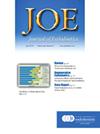Evaluating the Impact of Ultrasonic Irrigation on Bacterial Levels and Activity Following Chemomechanical Procedures
IF 3.5
2区 医学
Q1 DENTISTRY, ORAL SURGERY & MEDICINE
引用次数: 0
Abstract
Introduction
This single-arm interventional trial aimed to investigate the efficacy of ultrasonic irrigation as a supplementary disinfection approach after chemomechanical procedures (CMP) using molecular techniques based on ribosomal RNA (rRNA) and rRNA genes (referred to as DNA).
Methods
Samples were collected from 35 single-rooted teeth with radiographic evidence of apical periodontitis. Samples were taken after gaining root canal access (S1), (S2), and ultrasonic irrigation (S3). DNA-targeted quantitative polymerase chain reaction using universal primers was used to estimate total bacterial levels, while rRNA-targeted quantitative polymerase chain reaction was used to assess bacterial activity. Ratios between rRNA and DNA levels were calculated to search for active bacteria in the samples (rRNA/DNA ≥ 1). Wilcoxon matched-pairs signed-rank test was used to compare the differences in DNA levels between samples and DNA and rRNA levels within samples (P < .05).
Results
DNA-based methods revealed a significant decrease in bacterial levels from S1 to S2 and S2 to S3 (both P < .05). Notably, 11 out of 35 (31.4%) root canals did not harbor bacterial DNA after CMP, whereas ultrasonic activation increased DNA-negative samples to 17 (48.6%). However, all DNA-positive samples were also positive for rRNA, with significantly higher rRNA than DNA levels (P < .05), indicating bacterial activity at the sampling time.
Conclusions
Ultrasonic irrigation improved the disinfection of root canals after CMP by reducing bacterial levels. However, persisting bacteria remained active in the root canals after CMP and ultrasonic irrigation.
评估超声波冲洗对化学机械程序后细菌水平和活性的影响
目的:这项单臂干预试验旨在利用基于核糖体 RNA(rRNA)和 rRNA 基因(简称 DNA)的分子技术,研究超声波灌洗作为化学机械治疗后的辅助消毒方法的功效:从 35 颗有根尖牙周炎影像学证据的单根牙齿中采集样本。样本在获得根管通路(S1)、化学机械程序(CMP,S2)和超声波冲洗(S3)后采集。使用通用引物的 DNA 靶向 qPCR 用于估算细菌总数,而 rRNA 靶向 qPCR 则用于评估细菌活性。计算 rRNA 和 DNA 水平之间的比率,以寻找样本中的活性细菌(rRNA/ DNA ≥ 1)。采用 Wilcoxon 配对符号秩检验比较样本间 DNA 水平的差异以及样本内 DNA 和 rRNA 水平的差异(P 结果:基于 DNA 的方法显示,从 S1 到 S2,以及从 S2 到 S3,细菌水平明显下降(均为 P 结论:超声波灌洗提高了消毒效果:超声波灌洗通过降低细菌水平,改善了化学机械治疗后根管的消毒效果。然而,在 CMP 和超声波冲洗后,根管内的持续细菌仍然活跃。
本文章由计算机程序翻译,如有差异,请以英文原文为准。
求助全文
约1分钟内获得全文
求助全文
来源期刊

Journal of endodontics
医学-牙科与口腔外科
CiteScore
8.80
自引率
9.50%
发文量
224
审稿时长
42 days
期刊介绍:
The Journal of Endodontics, the official journal of the American Association of Endodontists, publishes scientific articles, case reports and comparison studies evaluating materials and methods of pulp conservation and endodontic treatment. Endodontists and general dentists can learn about new concepts in root canal treatment and the latest advances in techniques and instrumentation in the one journal that helps them keep pace with rapid changes in this field.
 求助内容:
求助内容: 应助结果提醒方式:
应助结果提醒方式:


